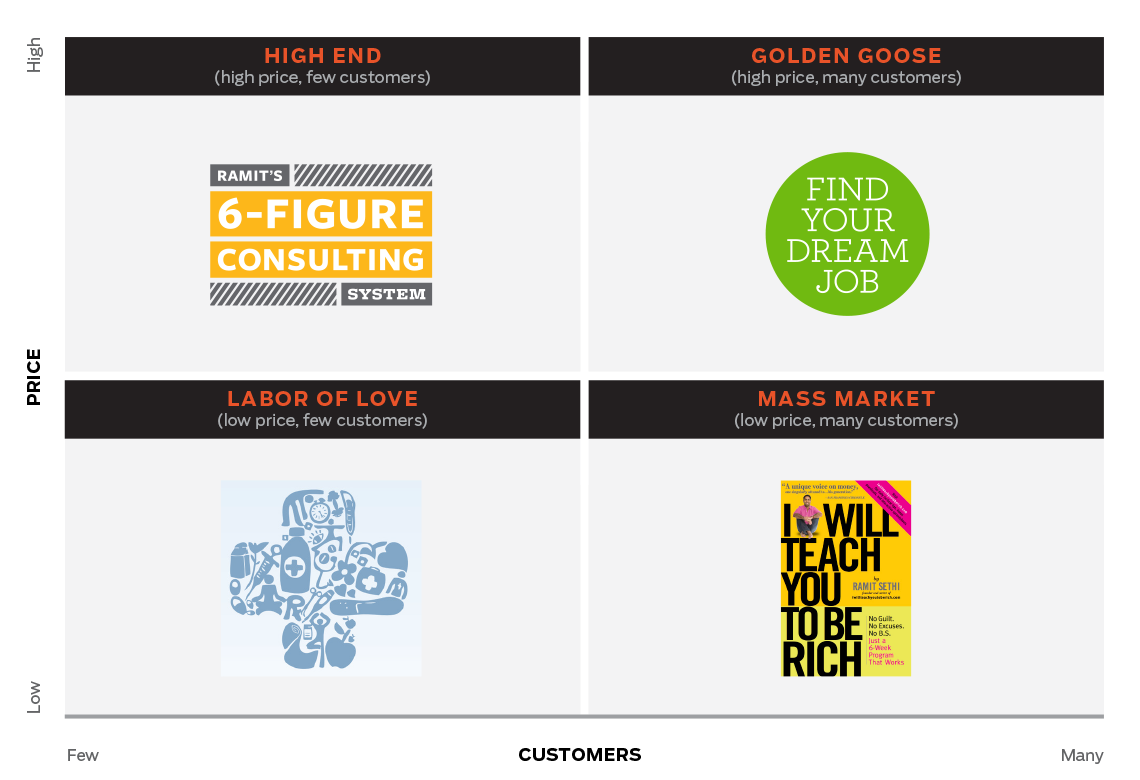
I Don’t Just Launch a Product and Pray. Here’s What I Do
If you were opening your own restaurant, what’s the #1 thing you’d want to ensure it was successful?
Maybe you want a great location right in the heart of downtown? A friendly, professional waitstaff? The most talented chefs? The freshest ingredients?
I miss food in California!! This was lunch today with friends
A video posted by Ramit Sethi (@ramit) on Apr 17, 2015 at 2:13pm PDT
I miss the food in California
Those are all important pieces. But would any of them ensure success?
More critical than any of those things, if you want to open a successful restaurant — or successful business of any kind — you need a hungry crowd.
You need a crowd that wants exactly what you’re selling and is willing to pay for it.
It seems obvious, but people forget this when they go to start a business. They get so wrapped up in their own ideas and sexy topics like web design and marketing that they never bother to find out if they even have a product people will pay for.
Ignoring this and making products nobody wants is why so many startups fail.
When creating products at IWT, we go through a deep research phase. Every hour we spend in this phase saves us tens of thousands of dollars down the line.
This testing is how you virtually guarantee your online business will succeed. Let’s walk through why people skip this, and then I’ll show you how we do it.
Table of Contents
3 Big Mistakes People Make After Finding a Business Idea
Why do most businesses flop?
People assume they know what others want — without ever asking. That’s why they’ll put all this time, money, and effort into a business, thinking it’ll be a home run, only to hear crickets when they finally launch.
Here are three of the most common assumptions people make that lead to flops:
- They assume everyone is like them. (“I love Russian novels, so I will create a 60-hour course about Crime and Punishment. I’ll be rich!”)
- They tried to make a one-size-fits-all product that appeals to everyone. (When you buy razors, do you buy general razors for anyone? Or razors for your gender?)
- They saw nobody else had their idea and thought that was a good thing. (No competition often means no demand.)
So how do you make sure you’ve got something people want?
Before you do anything — before you create the product, build a website, or start marketing — you’ll want to get to know your customers deeply. The way we put it is this: Like a good spouse knows their partner better than they know themselves, you want to know your customer even better than they know themselves.
Watch how we do it.
Want to build a business that enables you to live YOUR Rich Life? Get my FREE guide on finding your first profitable idea.
How to Virtually Guarantee Your Business Idea Will Work
Remember the demand matrix from the idea mapping checklist?

This matrix helped you figure out a list of potential ideas even if you don’t have one yet. Now it’s time to test these ideas through some deep research.
Finding your hungry crowd
Go out and talk to people who you think would be interested in your idea. You can do this online or (better) in person.
- If your idea involves helping people improve their dating lives, talk to your single friends to discover their struggles and challenges.
- If you want to help people cook healthy, paleo-friendly meals, talk to friends or family who would be interested in that lifestyle.
- If you want to show people how to improve their social skills, talk to introverted people to find out how they think about becoming more social.
Here’s what you can say to them:
Step 1: Find 1 person — JUST ONE! — who might be interested in your idea. You can do this via email or in person. If you’re unsure, ask ANYONE remotely close to the idea, even your parents. We’re not aiming for perfection right now, just a start.
Step 2: “Test” your idea using this script: “I’m thinking of starting some kind of website around [YOUR IDEA]. When you talk to your friends about it, what do you say? What’s the biggest problem around [YOUR IDEA]?”
Step 3: Write down the exact language they use. Did they really say, “I want a solution that’s easy, fast, and secure”? No, they did not. WRITE DOWN WHAT THEY ACTUALLY SAY. “I hate how these jeans look on me” is a terrific response. “Every day I wake up, I just dread going to work” is another.
When we shared these steps with IWT readers, the insights people got were incredible.
People realized ideas they thought were great would not have worked at all. And learned how to tweak mediocre ideas to make them irresistible and profitable.
Here’s an example where a reader shares her original business idea and the new idea she discovered after talking to someone she thought would be interested.
You’ll learn what she expected this friend to say, what she actually said, and how that totally changed her business plan.

Tanya learned that even though her initial idea seemed strong, it wasn’t actually what her customers wanted.
Do you see how crucial this is?
Tanya could have poured tons of time and money into creating a course that taught artists how to handle business — and nobody would have bought it!
Doesn’t matter how fancy her website or beautiful her logo or how many inspirational quotes she posted on Instagram.
Now that she has a better understanding of what her target market wants, she can speak to them with the actual words they use to describe things — in the marketing, in her products, and everywhere else. This isn’t just fancy semantics. You take these insights and make better products for customers.
By doing this, you remove a massive amount of risk from you business.
Talk to your customers and find out what they want, then create a product that fits their needs. This is how you virtually guarantee your product will be successful.
Creating the Perfect Product
When we work on a new product for IWT, we spend weeks, months, even years talking to people we think might be interested. I call this “immersion” — really going deep to understand who our audience is and what they want. This is way before we create or sell anything.
For example, we recently launched a $25,000 product for successful entrepreneurs. One feature we thought about adding was “Ramit’s Rolodex” — a list of freelancers and businesses we use at IWT that people could call on when they needed quality, trusted help in a hurry.
We reached out to people who we thought would be interested and asked their thoughts. We assumed they’d love it, but the reaction was lukewarm.
Here’s an actual email response from a potential customer we talked to.

Bottom line: Customer’s weren’t excited about “Ramit’s Rolodex,” so we didn’t make it.
Actually talking to people first kept us from wasting time creating something our target market didn’t care about. Instead we asked more questions, got more feedback, and created something that fit their needs exactly.
We don’t create products and hope people buy. We find out what our prospects want, make sure we can deliver something outstanding and 10x-100x better than anything out there, then give it to them. Talking to customers first and creating products based on their feedback is how we’ve launched over 18 successful products over the past 11 years.

Find Your Profitable Business Idea
What if you could build an online business that PAYS YOU to live the life you’ve always wanted? Find inspiration and get started today with this free downloadable PDF guide, 30 successful online businesses you can model, that’ll prove your existing skills can make you money. ↓
Want to build a business that enables you to live YOUR Rich Life? Get my FREE guide on finding your first profitable idea.
Written by Ramit Sethi
Host of Netflix’s “How To Get Rich” NYT Bestselling Author, & Host of the I Will Teach You To Be Rich Podcast. I’ll show you how to take control of your money with my proven strategies so you can live your RICH LIFE.



